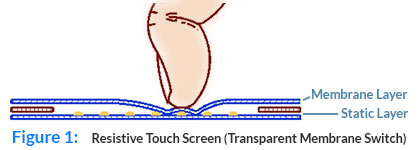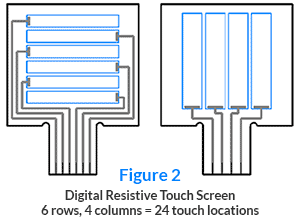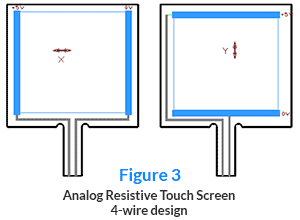Resistive Touch Screens
What is a Resistive Touch Screen?
The ASTM subcommittee on membrane switches defines a membrane switch as: “A momentary switch device in which at least one contact is on, or made of, a flexible substrate”. Resistive touch screen technology satisfies all of the requirements necessary to be classified as a membrane switch. If we take a closer look at the construction shown in figure 1, we see that a resistive touch screen is made up of a membrane layer and static layer separated by tiny dielectric dots that help to keep the switch open until a force is applied to the membrane layer.
The membrane, or flexing layer, is made of thin transparent, conductively coated polyester. When pressed, using finger or stylus, the transparent conductive coating makes ohmic (resistive) contact with the opposing transparent conductor, the static layer, on the other side of the switch.
The Static layer can be made of the same flexible material as the membrane layer or a clear rigid material, such as glass or strengthened glass that is also conductively coated. Adhesive material is applied only on the periphery of the transparent area for sealing purposes. However, there are small dielectric insulators that prevent the membrane and static layers from making contact when not being touched. The insulators dots also help control the actuation force necessary to close the switch.
In the past, one of the drawbacks to resistive touch screen technology is there are several layers and air gaps to look through, each contributing to light transmission loss and diffusion. This problem has been greatly reduced by using a process called optical bonding, where the static layer is bonded, using an optically clear adhesive, directly to a transparent rigid backer, thus eliminating one of the air gaps.
Despite minor drawbacks, resistive touch screen technology is generally considered the most popular type of touch screen. This growing popularity comes from the fact that resistive type touch screens are the least expensive of all touch screen technologies. In addition to low cost, the resistive touch screen design is totally sealed from outside contamination. This is important where NEMA 4 conditions must be met, especially in situations where gloves are frequently worn such as: Industrial Controls, Medical, and Test & Diagnostics applications.
Resistive touch screens can also be combined with a decorative graphic layer and standard membrane switch keyboard components to create a more user-friendly data input device.
Pannam’s resistive touch screen offerings include 4, 5, & 8 wire versions, as well as multi-touch versions.
There are two types of resistive touch screen technologies: Digital and Analog. The following sections provide a detailed explanation of the construction for both types.
Digital Resistive Touch Screens:
Sometimes referred to as the X-Y Matrix touch screen. The ITO coating is etched (or selectively applied) to form rows on one layer and columns on the opposite layer. When assembled, the rows and columns form a matrix of switches. Each switch is a permanent discrete switch location and the size cannot change. The resolution is dependent on the number of rows and columns. Digital touch screens are as easy to interface with as a conventional membrane switch keyboard and are popular when finger size touch zones are required. See figure 2 for an example of a 6 row, 4-column digital touch screen that once assembled will have 24 individual touch locations.
Analog Resistive Touch Screen
The analog touch screen is a construction used on pen recognition type computers or when a much higher resolution of switches is required than is possible with the digital design. Resolution of the analog touch screen is limited only by the lighted panel behind the touch screen and can easily reach 1400 dpi or better. Also you only need a 4 or 5-pin connector whereas the digital requires one pin for each row and each column. The analog membrane layer carries the X (or Y) axis and the non-flexing layer (static layer) carries the opposite axis.
Each axis must remain perfectly linear. Since the membrane layer is flexing there is a possibility for fracturing of the ITO (conductive coating), especially along the edge of the transparent area, leading to failure and calibration loss. However most manufacturers guarantee at least 1 million actuations in any given touch area.
The example shown in Figure 3 is a 4-wire analog touch screen. When the two layers are placed on top of each other you basically have a single switch, i.e., no matter where you touch between the bus bars, you close the same switch. However, the computer will detect location based on the voltage drop sensed in the X (membrane layer) and Y (static layer). That information is processed by the CPU and shown as a location on the digital display.
What are the Advantages of Resistive Touch Screens?
- Most cost-effective touch screen technology
- Easy integration into value-added, turnkey membrane switch assemblies
- Can be operated with gloves and pen/stylus as well as human fingers
- High resistance to dust, moisture and humidity
- Works with handwriting recognition systems
Let Pannam Integrate Your Touch Screen into a Custom User-Interface
While Pannam can supply you with a standalone custom-designed or off-the-shelf touch screen, our core competency is the integration of your touch screen into a complex, feature-rich user-interface assembly. Pannam will also integrate a touch screen from a supplier of your choosing, if you prefer.
Pannam’s advanced fabrication capabilities and network of qualified suppliers enables us to source all the sub-components needed to successfully complete your project. The result is that you work with one dependable partner, saving you valuable time and money, while decreasing time to market. In addition to the touch screen, technologies and components you may consider for incorporation into your assembly include:
- Membrane switch keypads
- Silicone rubber keypads
- Printed circuit board controller electronics – rigid (PCB) and flexible (FPC)
- Rigid support back panels (aluminum, stainless steel, acrylic, FR4, etc) with PEM mounting hardware
- Bezels, enclosures, housings
- Advanced printing capabilities for high-resolution images and half-tone effects
- Backlighting options (LEDs, optical fibers, electroluminescent)
- Nameplates & labels for logos, branding, instruction, rating
- Bar Coded nameplates and labels for asset tracking – 2D and 3D bar codes


